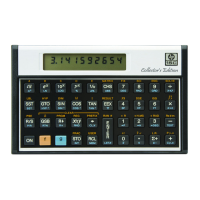Section 6: Programming Basics 79
For example, ´ b ´ A becomes ´ b A, ´ m ´ %
becomes ´ m %, and O ´ # becomes O #.
The removal of the ´ is not ambiguous because the ´-shifted function
is the only logical one in these cases. The keycodes for such instructions do
not include the extraneous ´ even if you do key it in.
User Mode
User mode is a convenience to save keystrokes when addressing (calling
up) programs for execution. Pressing ´ U will exchange the
primary functions and ´-shifted functions of the A through E keys
only. In User mode (USER annunciator displayed):
´
Primary
¤
'
@
y
⁄
| shift
x
2
LN LOG % Δ%
Press ´ U again to deactivate User mode.
Polynomial Expressions and Horner’s Method
Some expressions, such as polynomials, use the same variable several
times for their solution. For example, the expression
f(x) = Ax
4
+ Bx
3
+ Cx
2
+ Dx + E
uses the variable x four different times. A program to solve such an
equation could repeatedly recall a stored copy of x from a storage
register. A shorter programming method, however, would be to use a
stack which has been filled with the constant (refer to Loading the Stack
with a Constant, page 41).
Horner’s Method is a useful means of rearranging polynomial expressions
to cut calculation steps and calculation time. It is especially expedient in
_ and f, two rather long-running functions that use subroutines.
This method involves rewriting a polynomial expression in a nested
fashion to eliminate exponents greater than 1:
Ax
4
+ Bx
3
+ Cx
2
+
Dx + E
(Ax
3
+ Bx
2
+ Cx + D)x + E
((Ax
2
+ Bx + C)x + D)x + E
(((Ax + B)x + C)x + D)x + E

